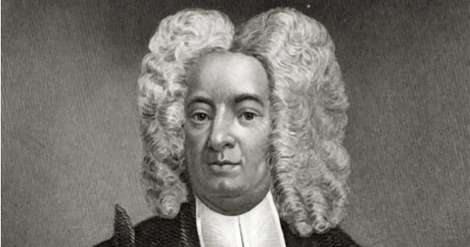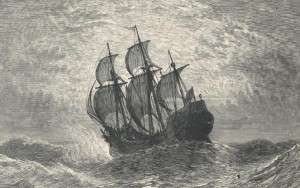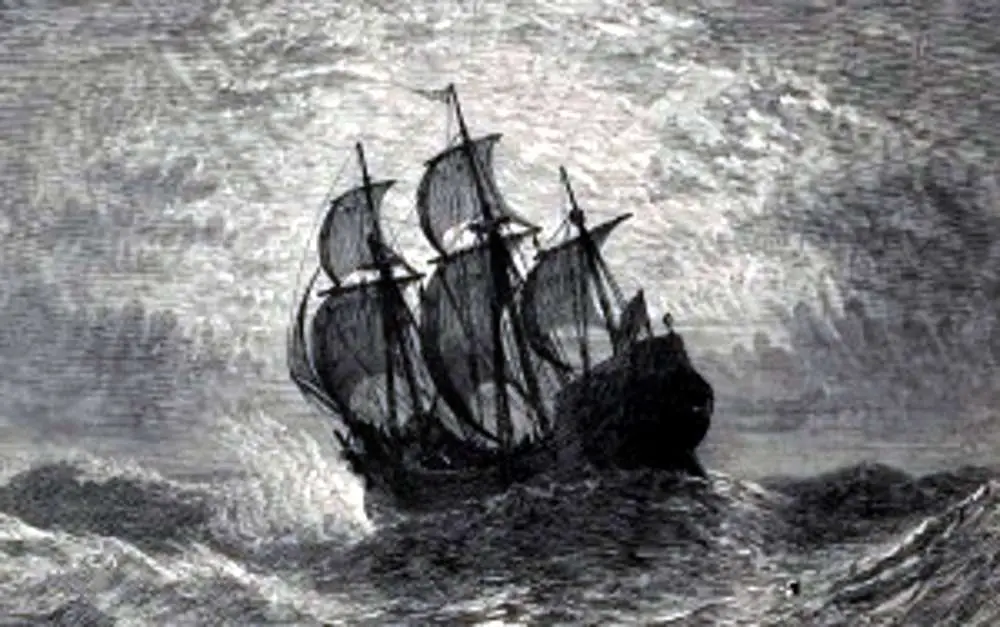Rev. Cotton Mather was nothing if not a prolific storyteller and historian (as well as a supporter of the Salem witch trials). His writings, more than 400 books and pamphlets, informed many people living back in England about America. In his Magnalia Christi Americana he told of the ways God was at work in America. John Greenleaf Whittier drew on the work for his poem about the ghost ship of Salem.

Cotton Mather
The setting was the main wharf in early Salem, Mass., sometime before 1675. At that time, colonists return to England to visit family, to tend to their estates or fight the English Civil War..
But no sea voyage was without risks, and Mather’s story captures four of the colonists’ overriding concerns: fear of ocean travel, suspicion of strangers, grappling with harsh nature and supernatural occurrences.
Ghost Ship of Salem
In this story, a strange young couple arrives in Salem to make passage on the vessel Noah’s Dove. The people of the town are leery of the strangers. Some take their presence as a bad sign. But the ship is headed to England and on the day of its departure, the passengers – eager for a taste of England – are bent on leaving.
The wharf is crowded with passengers getting on the ship and those seeing them off. As the boarding continues, a raven flies overhead and lands on one of the hands of the town clock, pushing it forward ten minutes.
The sight makes the crowd even more uneasy. As the ship’s crew casts off lines in preparation to sail, fights break out among some of the departing passengers and their wary friends and families staying behind and trying to discourage them from leaving.
 Into the scene, the two strangers arrive – husband and wife. She cries as they board. No sooner have they set foot on the boat then a breeze kicks up and carries the ship out to sea. Within hours, the breeze has turned into an all-out storm. Hail, thunder, lighting and strong winds all lash the sea for three solid days.
Into the scene, the two strangers arrive – husband and wife. She cries as they board. No sooner have they set foot on the boat then a breeze kicks up and carries the ship out to sea. Within hours, the breeze has turned into an all-out storm. Hail, thunder, lighting and strong winds all lash the sea for three solid days.
The Noah’s Dove has surely perished, the townspeople say. On the fourth day, the sun comes out and the townspeople go to the harbor. In the distance they see a sailing vessel. The off-shore winds will prevent it from landing for at least a day, cautions one old salt. But the ship defies logic. It sails forward straight into the wind and toward the shore.
Shipwreck
The Rev. Zebedee Stibbin, shaken by the sight, leads some in reciting the 46th Psalm for comfort: “God is our refuge and strength, a very present help in trouble. Therefore will not we fear . . .”
The Noah’s Dove steadily presses on toward land, and as it nears the passengers can be seen. The young couple, the strangers, stand arm in arm on the deck. But they are dead silent and don’t seem to even be aware of the approaching shore.
Suddenly, the masts of the ship collapse, and with one huge thunderclap and flash of lightning, the ship sinks to the bottom.
The story had such power that people retold it for 300 years.
This story was updated in 2022.

10 comments
How strange. Interesting story.
Spooky
Wow
Oh my gosh, if this is true, oh my gosh!
I am just imagine the Colonists telling and retelling this story with great embellishments!
[…] of the story and began publishing accounts of the strange happenings. Since everyone loves a good haunting or curse, curious strangers began stopping by, hoping to glimpse an unusual event or witness the […]
[…] age 36. Her story was recalled by Sarah Anna Emery in her Reminiscences of a Nonagenarian. Master storyteller John Greenleaf Whittier made her story the centerpiece in his fictionalized tale of New England […]
[…] the mourning citizens find comfort in knowing how their loved ones had perished. The story of the phantom ship was later turned into a popular poem by Henry Wadsworth […]
[…] Knockings and began publishing accounts of the strange happenings. Since everyone loves a good haunting or curse, curious strangers began stopping by, hoping to glimpse an unusual event or witness the […]
[…] the Flying Dutchman or the Ghost Ship of Salem, the legend of the ghost ship has endured for […]
Comments are closed.